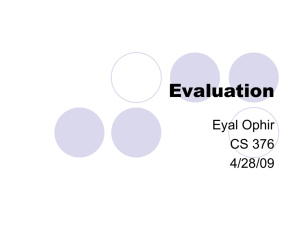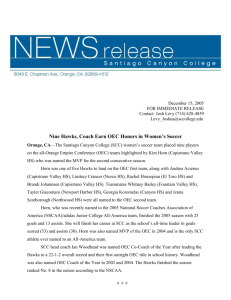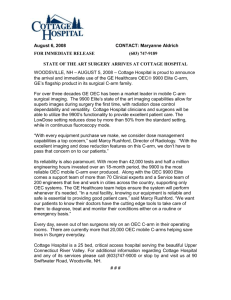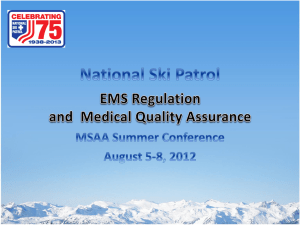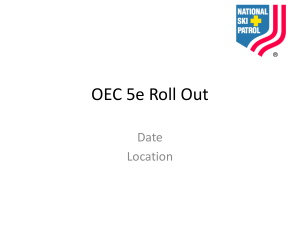PPTX - Exp Platform
advertisement
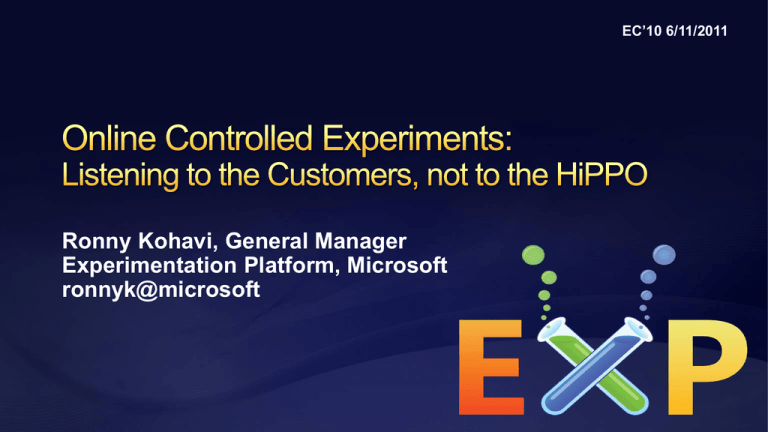
EC’10 6/11/2011 Ronny Kohavi, General Manager Experimentation Platform, Microsoft ronnyk@microsoft I have three key lessons to share. We’ll first do a Cambridge version of them. You’re responsible for operations of the traffic lights in Cambridge, and there’s one intersection where there are always problems with the light Do you A - Send an engineer to find the root cause, which is estimated to take a few days B – Put up a sign with a phone number to call when the lights don’t work Key lesson in this talk: it depends on your OEC, the Overall Evaluation Criterion, or what you’re optimizing for Good OEC: Uptime (% of time light is properly operating) The twist: what’s the time horizon? Are you optimizing for uptime this week, or for the next year? In Cambridge, it’s B – put up a sign A retailer like Amazon should optimize for long-term customer lifetime value, not short term revenue. Picking a good OEC is key You’re planning a conference that takes place in June There’s a dinner cruise planned Do you run the conference in A: Seattle, WA B: Cambridge, MA Both have good waterfronts and boats What should you ask first? What’s the OEC, the Overall Evaluation Criterion The OEC can have multiple terms, but let’s focus on rain. We want to minimize the probability that it will rain during the cruise What do you do? Lesson #2: GET THE DATA Cambridge gets over double the rainfall in June You’re responsible for programming the Sheraton Commander elevators here in the Cambridge Scenario: Both elevators are at the Lobby floor, doors closed Someone comes in from the Lobby and hits the “up” button Do you program the elevators to A – Open the left elevator’s door B – Open the right elevator’s door C – Open both doors First question you should ask? What’s the OEC Answer: mean time to get customer to their floor Now what? Lesson #2: Get the data! Anyone staying at the conference hotel that knows the critical data? Right elevator is 3x faster. Open that door. Here’s the data: Left Elevator Lesson #3: Prepare to be humbled Right Elevator Lesson #1: Ask what is the OEC? (Overall Evaluation Criterion) What are we optimizing for? Lesson #2: Get the Data Lesson #3: Prepare to be humbled In many scenarios getting the data is hard On the web, it’s easy – we can run controlled experiments We can get the data, and it trumps our intuition 10 Add an item to your shopping cart at a website Most sites show the cart At Amazon, Greg Linden had the idea of showing recommendations based on cart items Evaluation Pro: cross-sell more items (increase average basket size) Con: distract people from checking out (reduce conversion) HiPPO (Highest Paid Person’s Opinion) was: stop the project Simple experiment was run, wildly successful, and the rest is history From Greg Linden’s Blog: http://glinden.blogspot.com/2006/04/early-amazon-shopping-cart.html 11 Controlled Experiments in one slide Examples: you’re the decision maker Cultural evolution: hubris, insight through measurement, Semmelweis reflex, fundamental understanding (Erik Brynjolfsson presented 4 stages: measurement, experiment, share, replicate; this model starts earlier and ends later.) Quick overview of pros/cons of controlled experiments Technical papers, more examples, the detailed statistics, tutorials are all at http://exp-platform.com (URL printed on the HiPPOs) 12 Concept is trivial Randomly split traffic between two (or more) versions A (Control) B (Treatment) Collect metrics of interest Analyze Must run statistical tests to confirm differences are not due to chance Best scientific way to prove causality, i.e., the changes in metrics are caused by changes introduced in the treatment(s) 13 Three experiments that ran at Microsoft All had enough users for statistical validity Game: see how many you get right Everyone please stand up Three choices are: A wins (the difference is statistically significant) A and B are approximately the same (no stat sig diff) B wins If you guess randomly 1/3 left standing after first question 1/9 after the second question 14 “Find a house” widget variations Overall Evaluation Criterion(OEC): Revenue to Microsoft generated every time a user clicks search/find button A • Raise your right hand if you think A Wins • Raise your left hand if you think B Wins • Don’t raise your hand if you think they’re about the same B 15 If you did not raise a hand, please sit down If you raised your left hand, please sit down A was 8.5% better Since this is the #1 monetization, it effectively raised revenues significantly Actual experiment had 6 variants. If you’re going to experiment, try more variants, especially if they’re easy to implement OEC: Clickthrough rate for Search box and popular searches A B Differences: A has taller search box (overall size is the same), has magnifying glass icon, “popular searches” B has big search button • Raise your right hand if you think A Wins • Raise your left hand if you think B Wins • Don’t raise your hand if they are the about the same 17 If you raised any hand, please sit down Insight Stop debating, it’s easier to get the data 18 A later test showed that changing the magnifying glass to an actionable word (search, go, explore) was highly beneficial. This: is better than OEC: Clicks on revenue generating links (red below) A • Raise your right hand if you think A Wins • Raise your left hand if you think B Wins • Don’t raise your hand if they are the about the same B 20 If you did not raise a hand, please sit down If you raised your left hand, please sit down B was 64% worse What % of the audience is still standing? Humbling! Remember lessons #2 and #3: get the data and prepare to be humbled 21 Any statistic that appears interesting is almost certainly a mistake If something is “amazing,” find the flaw! Examples If you have a mandatory birth date field and people think it’s unnecessary, you’ll find lots of 11/11/11 or 01/01/01 If you have an optional drop down, do not default to the first alphabetical entry, or you’ll have lots jobs = Astronaut The previous Office example assumes click maps to revenue. Seemed reasonable, but when the results look so extreme, find the flaw (conversion rate is not the same; see why?) 22 QualPro tested 150,000 ideas over 22 years 75 percent of important business decisions and business improvement ideas either have no impact on performance or actually hurt performance… At Amazon, half of the experiments failed to show improvement Based on experiments with ExP at Microsoft 1/3 of ideas were positive ideas and statistically significant 1/3 of ideas were flat: no statistically significant difference 1/3 of ideas were negative and statistically significant Our intuition is poor: 2/3rd of ideas do not improve the metric(s) they were designed to improve. Humbling! Avoid the temptation to try and build optimal features through extensive planning without early testing of ideas Experiment often To have a great idea, have a lot of them -- Thomas Edison If you have to kiss a lot of frogs to find a prince, find more frogs and kiss them faster and faster -- Mike Moran, Do it Wrong Quickly Try radical ideas. You may be surprised Doubly true if it’s cheap to implement (e.g., shopping cart recommendations) If you're not prepared to be wrong, you'll never come up with anything original – Sir Ken Robinson, TED 2006 24 If you remember one thing from this talk, remember this point OEC = Overall Evaluation Criterion Agree early on what you are optimizing Getting agreement on the OEC in the org is a huge step forward Suggestion: optimize for customer lifetime value, not immediate short-term revenue Criterion could be weighted sum of factors, such as Time on site (per time period, say week or month) Visit frequency Report many other metrics for diagnostics, i.e., to understand the why the OEC changed and raise new hypotheses 25 Controlled Experiments in one slide Examples: you’re the decision maker Cultural evolution: hubris, insight through measurement, Semmelweis reflex, fundamental understanding Quick overview of pros/cons of controlled experiments 26 It is difficult to get a man to understand something when his salary depends upon his not understanding it. -- Upton Sinclair Why people/orgs avoid controlled experiments Some believe it threatens their job as decision makers At Microsoft, program managers select the next set of features to develop. Proposing several alternatives and admitting you don’t know which is best is hard Editors and designers get paid to select a great design Failures of ideas may hurt image and professional standing. It’s easier to declare success when the feature launches We’ve heard: “we know what to do. It’s in our DNA,” and “why don’t we just do the right thing?” The org goes through stages in its cultural evolution Stage 1: we know what to do and we’re sure of it True story from 1849 John Snow claimed that Cholera was caused by polluted water A landlord dismissed his tenants’ complaints that their water stank Even when Cholera was frequent among the tenants One day he drank a glass of his tenants’ water to show there was nothing wrong with it He died three days later That’s hubris. Even if we’re sure of our ideas, evaluate them Controlled experiments are a powerful tool to evaluate ideas Measurement • Semmelweis worked at Vienna’s General Hospital, an important teaching/research hospital, in the 1830s-40s • In 19th-century Europe, childbed fever killed more than a million women • Measurement: the mortality rate for women giving birth was • 15% in his ward, staffed by doctors and students • 2% in the ward at the hospital, attended by midwives Insight Control • He tries to control all differences • Birthing positions, ventilation, diet, even the way laundry was done • He was away for 4 months and death rate fell significantly when he was away. Could it be related to him? • Insight: • Doctors were performing autopsies each morning on cadavers • Conjecture: particles (called germs today) were being transmitted to healthy patients on the hands of the physicians He experiments with cleansing agents • Chlorine and lime was effective: death rate fell from 18% to 1% Success? No! Disbelief. Where/what are these particles? Semmelweis was dropped from his post at the hospital He goes to Hungary and reduced mortality rate in obstetrics to 0.85% His student published a paper about the success. The editor wrote We believe that this chlorine-washing theory has long outlived its usefulness… It is time we are no longer to be deceived by this theory In 1865, he suffered a nervous breakdown and was beaten at a mental hospital, where he died Semmelweis Reflex is a reflex-like rejection of new knowledge because it contradicts entrenched norms, beliefs or paradigms Only in 1800s? No! A 2005 study: inadequate hand washing is one of the prime contributors to the 2 million health-care-associated infections and 90,000 related deaths annually in the United States In 1879, Louis Pasteur showed the presence of Streptococcus in the blood of women with child fever 2008, 143 years after he died, there is a 50 Euro coin commemorating Semmelweis Hubris Measure and Control Accept Results avoid Semmelweis Reflex Fundamental Understanding In many areas we’re in the 1800s in terms of our understanding, so controlled experiments can help First in doing the right thing, even if we don’t understand the fundamentals Then developing the underlying fundamental theories 33 Controlled Experiments in one slide Examples: you’re the decision maker Cultural evolution: hubris, insight through measurement, Semmelweis reflex, fundamental understanding Quick overview of pros/cons of controlled experiments 34 With data mining, we find patterns, but most are correlational, providing hypotheses for possible causes Here is one a real example of two highly correlated variables 35 • Real Data for the city of Oldenburg, Germany • X-axis: stork population • Y-axis: human population What your mother told you about babies and storks when you were three is still not right, despite the strong correlational “evidence” Ornitholigische Monatsberichte 1936;44(2) 37 Controlled experiments test for causal relationships, not simply correlations When the variants run concurrently, only two things could explain a change in metrics: 1. The “feature(s)” (A vs. B) 2. Random chance Everything else happening affects both the variants For #2, we conduct statistical tests for significance The gold standard in science and the only way to prove efficacy of drugs in FDA drug tests 38 If you don't know where you are going, any road will take you there —Lewis Carroll Scope: Experimentation is not applicable everywhere Necessary ingredients for experimentation to be useful detailed in paper at http://exp-platform.com/expMicrosoft.aspx Sweet spot: websites and services that practice agile development Org has to agree on OEC (Overall Evaluation Criterion) This is hard, but it provides a clear direction and alignment Some people claim their goals are “soft” or “intangible” and cannot be quantified. Give them Hubbard’s How to Measure Anything Quantitative metrics, not always explanations of “why” A treatment may lose because page-load time is slower. At Amazon, we slowed pages by 100-250msec and lost 1% of revenue A treatment may have JavaScript that fails on certain browsers, causing users to abandon 39 Primacy/novelty effect Changing navigation in a website may degrade the customer experience (temporarily), even if the new navigation is better Evaluation may need to focus on new users, or run for a long period Consistency/contamination On the web, assignment is usually cookie-based, but people may use multiple computers, erase cookies, etc. Typically a small issue Launch events / media announcements sometimes preclude controlled experiments The journalists need to be shown the “new” version Run A/A tests Run an experiment where the Treatment and Control variants are coded identically and validate the following: 1. Are users split according to the planned percentages? 2. Is the data collected matching the system of record? 3. Are the results showing non-significant results 95% of the time? This is a powerful technique for finding bugs and other integration issues before teams try to make data-driven decisions Generating some numbers is easy Getting correct numbers you trust is much harder! 41 Ramp-up Start an experiment at 0.1% Do some simple analyses to make sure no egregious problems can be detected Ramp-up to a larger percentage, and repeat until 50% Big differences are easy to detect because the min sample size is quadratic in the effect we want to detect Detecting 10% difference requires a small sample and serious problems can be detected during ramp-up Detecting 0.1% requires a population 100^2 = 10,000 times bigger Abort the experiment if treatment is significantly worse on OEC or other key metrics (e.g., time to generate page) 42 Novice experimenters run 1% experiments To detect an effect, you need to expose a certain number of users to the treatment (based on power calculations) Fastest way to achieve that exposure is to run equalprobability variants (e.g., 50/50% for A/B) Rare exception: biggest sites in the world. On the MSN US home page, we sample 10% of traffic If you perceive risk, don’t start an experiment at 50/50% from the beginning: Ramp-up over a short period 43 The less data, the stronger the opinions 1. Empower the HiPPO with data-driven decisions Hippos kill more humans than any other (non-human) mammal (really) OEC: make sure the org agrees what you are optimizing (long term lifetime value) 2. It is hard to assess the value of ideas Listen to your customers – Get the data Prepare to be humbled: data trumps intuition 3. Compute the statistics carefully Getting a number is easy. Getting a number you should trust is harder 4. Experiment often Triple your experiment rate and you triple your success (and failure) rate. Fail fast & often in order to succeed Accelerate innovation by lowering the cost of experimenting ExP is used at multiple properties at Microsoft, some of the largest in the world If you love data, we have lots of it If you like challenges, we have lots of them We have full-time openings We have 7 interns this summer We can take interns during the year (e.g., one quarter) See http://exp-platform.com E-mail ronnyk@ you know what
